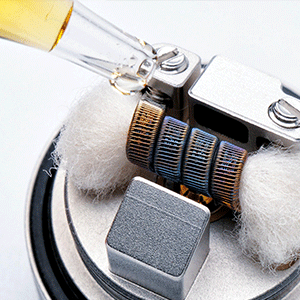
If you’re happily vaping along with a premium yet simplistic vape kit that’s easy to set up and use, this guide isn’t essential reading. Nevertheless, whatever your stage is in the vaping journey, knowing the basics such as the different vaping coil materials and each unique quality they possess is useful. If you’re interested in rebuilding your atomiser and all that they can do for you, these basics are a must. After all, any vapour device we use will have one.
The Purpose of a Vape Coil Wire
A vape coil wire plays a very important role in your overall experience. It will form the coil, which works to build up the heat with the help of your battery and transmit them to your wick so it can be heated. Once your wick soaked with e-liquid is heated, then that lovely vapour will be produced. It’s not just central to your atomiser but how your vape will operate too.
Gauge and Resistance - the Key Terminology Explained
Before we go on to discussing the different types of coil wire, there are some terms you should understand. The first is the gauge, which is simply the diameter and thickness of the wire. A higher gauge number will mean a thinner wire and smaller diameter. Typically coil wire is somewhere between 22 and 32 gauge.
Resistance, measured in Ohms is equally important. As the size of your wire goes up, the wire’s resistance decreases. Therefore, a thinner wire with a 30 gauge will have more resistance but will also heat up quicker than a 22 gauge wire. A thicker wire creates less electrical resistance because more current will pass through.
Lastly, you should know what ramp time is. This is the time it takes for your coil to reach the minimum temperature needed for vaporising your e-liquid. With a bigger mass, you’ll see a lower gauge number which takes longer to heat up. For a quicker ramp-up time, thinner wire is the best choice.

Different types of coil wire will behave differently to electricity and heat, and thus will have their own sets of pros and cons. Let’s take a look at the four most popular types and what each can offer you.
1.Kanthal – As one of the most widely available types of coil wire, Kanthal is extremely popular. Easy to acquire, it’s also cheap and often the starting point for anyone trying to build their coil. It's a little slow in ramp-up time but still very popular with vapers.
2.Stainless Steel – In contrast to Kanthal, using stainless steel provides a very quick ramp time. It’s also one of the easiest wire types to manipulate and create shapes, with a stronger hold. The potential nickel content (which is very low) creates a dilemma for a small group of vapers, due to potential allergies as explained here by the NHS.
3.Titanium – This is one of the least used of the four that we have covered. Titanium does have some strong points. It is really simple to work with and it does a great job in combination with most wicking material. Yet, there are concerns. Titanium is known to release a toxic compound at extremely high temperature and it is hard to put out if for some reason it did catch fire. This isn’t a concern for the people that use it and swear by it, but it’s enough to make most people opt for Kanthal or stainless steel instead.
4.Nichrome – This type of wire is an alloy made of nickel and chromium. The points in favour of using nichrome (NiCh) are that it holds its shape well, and it can ramp up quickly. On the downside, it’s that it isn’t so easy to find, so you’ll probably have to search online to get it.
Is Mesh Coil Better Than Standard Wiring?
In the past, every coil was shaped the traditional way, wrapped around the wick. However, in more recent times we have seen the emergence of the mesh coil, which enhances the flavour and boosts the temperature at a quicker rate due to a larger surface area. This coupled with the perforated holes and unique style started by Freemax is now a popular trend with Sub-Ohm vapers using high VG e-liquid

Important Consideration - Temperature Control
Vaping is about fine-tuning your experience to get the right hit from your device. With so many finer points to iron out, coils are only one part of the equation. You have to consider how many watts you want to vape at, the flavour consistency expected from your coils - even the sort of cloud production you want. The mode or settings you adjust will also play a part. For instance, many beginner and advanced vapers alike question whether temperature control (TC) is the way to go, or your vape should be tailored towards adjustable wattage.
Before choosing which route to go down, it’s important to understand that not all coil wire types are compatible with the various modes vape mods offer. To break it down:
1.Coil wires such as nickel and titanium do not work in wattage mode but are compatible with temperature control mods. This is because they offer a vape wire that increases in resistance. The advantage of NiCh and stainless steel, which is explained in more depth below, is the greater protection of your cotton. It will not burn if you are low on e-liquid in TC mode with these two coil wire types.
2.In contrast, Kanthal and nichrome do not work in TC mode. Because they operate on a static current, this makes increasing the heat a real challenge, increasing the chances of your coils burning out or even overloading. However, they work perfectly fine in adjustable wattage mode.
For those vapers still tossing and turning at night, unsure which option to go for, stainless steel is the safe choice. With stainless steel, you’ve got a jack of all trades that ticks both boxes, working for not just adjustable wattage mods but temperature control too.
Which Vape Coil Wire is Best for Flavour?
Although nichrome should be avoided if you have a nickel allergy and to an extent stainless steel vape wires, for flavour alone lots of vapers believe these two types offer the best flavour for vaping. Even more so than Kanthal, which tends to be the popular choice for price and durability. Overall, it depends on whether you want quantity or quality. A lot of vaping is trial and error - adjusting your device, e-liquids and set up to find the perfect match.

Pre-Build Coils vs Build Your Own - Verdict
Now that you know the basics of coils; including their function, the different types and how they work in various modes, you should have enough knowledge to take your vaping experience to the next level. For those who Sub-Ohm vape, you already have a lot to think about to get the best results. When you want to maximise the performance of your vape on the go, the main considerations include how to get the largest cloud production and enhancing the flavour as much as possible. Some vapers choose to do so manually themselves, but this requires a greater effort and additional time. To do so, you’ll need the following:
·Scissors to cut the wicking material (often cotton) in a neat manner
·Tweezers to test the coil resistance safely, known as ‘pulsing’
·Your wire of choice
·Wire cutters
·A screwdriver or metal tool to shape and tighten the coils and bolts holding the coils in place
While building your coils has a couple of advantages, giving you greater control over customising the vaping mod you select at a slightly cheaper price, most still opt for pre-built coils. The main reasons for this include:
1.Easier to use, simply slotting the Sub-Ohm coil into your vape mod or already installed in some vape pod kits for MTL vapers.
2.No need to fiddle about with components and wires.
3.Fewer parts to buy and do not need to source each aspect individually.
4.The likes of SMOK, Innokin and Aspire produce a great range of stylish and easy-to-use coils.
